外研版(2019)选择性必修第三册Unit 6 Nature in words Writing & Presenting ideas 课件(共15张PPT)
文档属性
| 名称 | 外研版(2019)选择性必修第三册Unit 6 Nature in words Writing & Presenting ideas 课件(共15张PPT) | 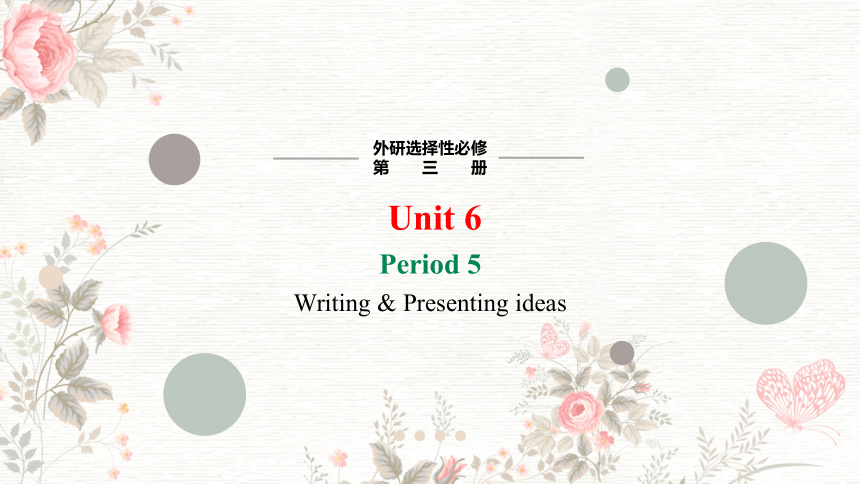 | |
| 格式 | pptx | ||
| 文件大小 | 5.4MB | ||
| 资源类型 | 教案 | ||
| 版本资源 | 外研版(2019) | ||
| 科目 | 英语 | ||
| 更新时间 | 2024-03-21 11:44:34 | ||
图片预览

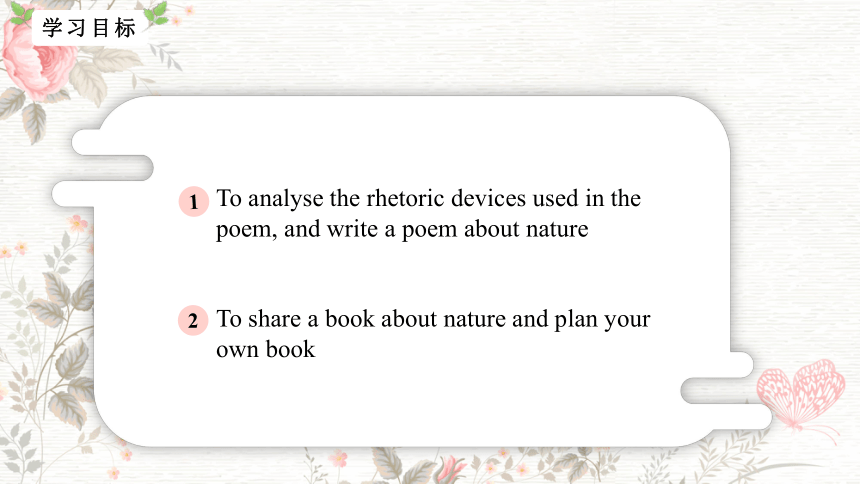
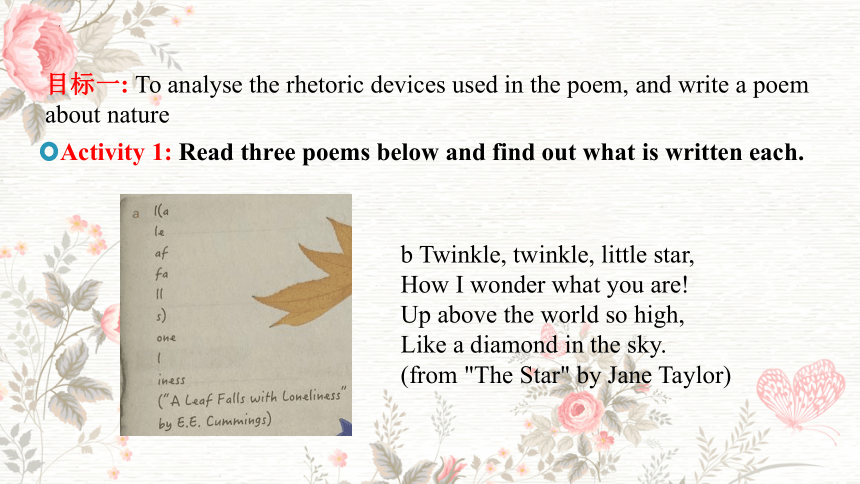
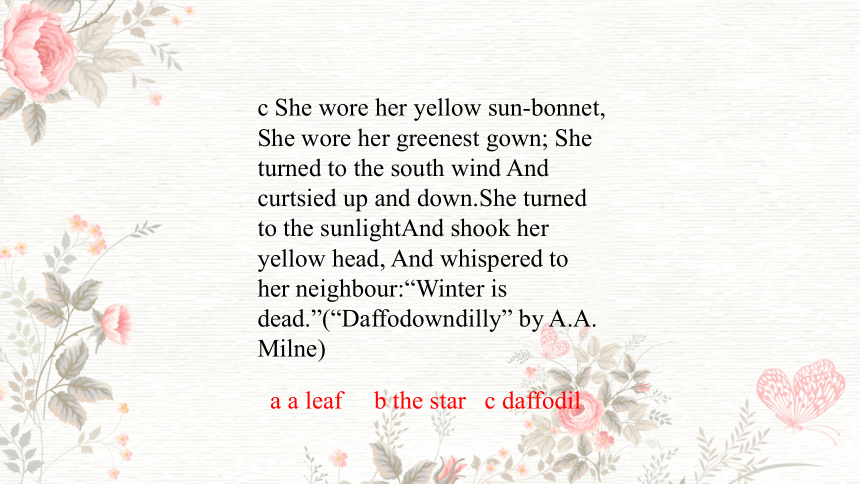
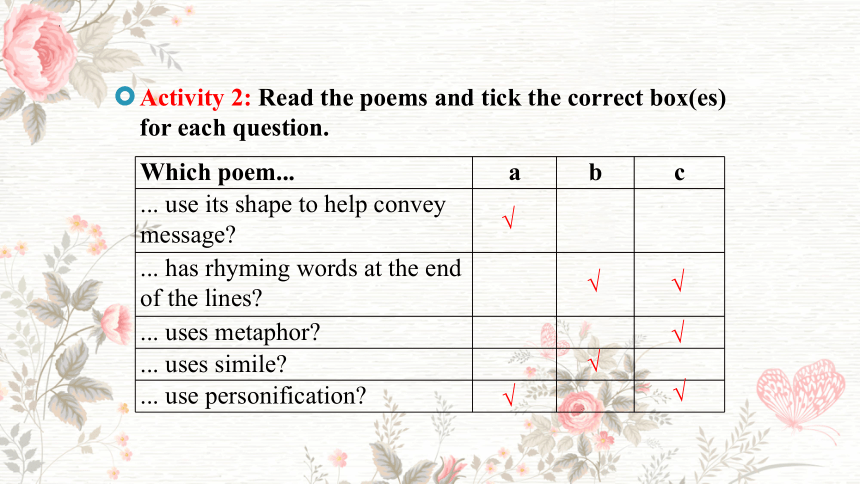
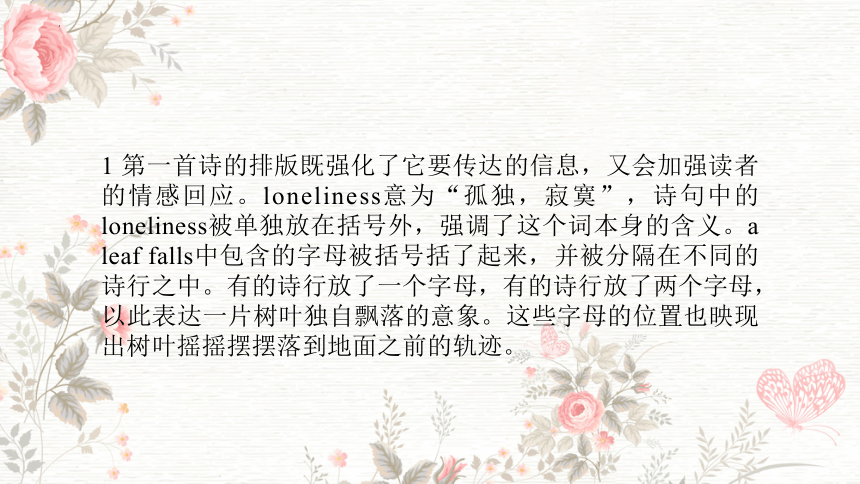
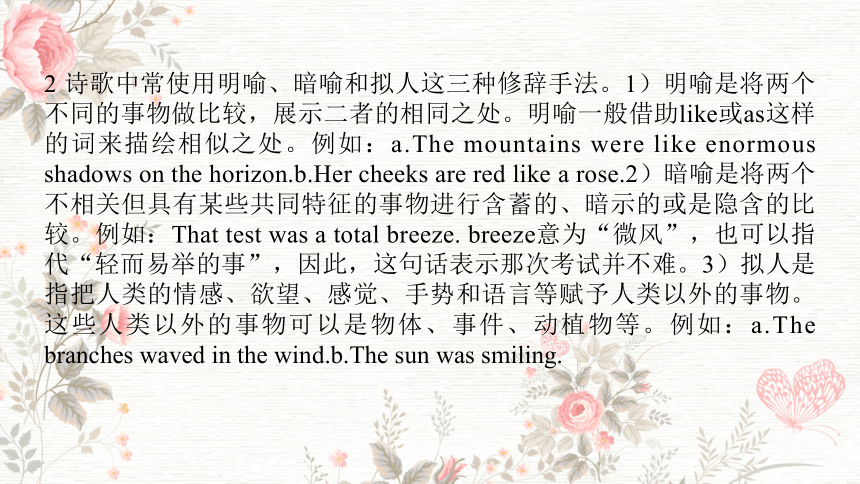
文档简介
(共15张PPT)
外研选择性必修
第三册
Unit 6
Period 5
Writing & Presenting ideas
1
2
To analyse the rhetoric devices used in the poem, and write a poem about nature
To share a book about nature and plan your own book
目标一: To analyse the rhetoric devices used in the poem, and write a poem about nature
Activity 1: Read three poems below and find out what is written each.
b Twinkle, twinkle, little star,
How I wonder what you are!
Up above the world so high,
Like a diamond in the sky.
(from "The Star" by Jane Taylor)
c She wore her yellow sun-bonnet, She wore her greenest gown; She turned to the south wind And curtsied up and down.She turned to the sunlightAnd shook her yellow head, And whispered to her neighbour:“Winter is dead.”(“Daffodowndilly” by A.A. Milne)
a a leaf b the star c daffodil
Activity 2: Read the poems and tick the correct box(es) for each question.
Which poem... a b c
... use its shape to help convey message
... has rhyming words at the end of the lines
... uses metaphor
... uses simile
... use personification
√
√
√
√
√
√
√
1 第一首诗的排版既强化了它要传达的信息,又会加强读者的情感回应。loneliness意为“孤独,寂寞”,诗句中的loneliness被单独放在括号外,强调了这个词本身的含义。a leaf falls中包含的字母被括号括了起来,并被分隔在不同的诗行之中。有的诗行放了一个字母,有的诗行放了两个字母,以此表达一片树叶独自飘落的意象。这些字母的位置也映现出树叶摇摇摆摆落到地面之前的轨迹。
2 诗歌中常使用明喻、暗喻和拟人这三种修辞手法。1)明喻是将两个不同的事物做比较,展示二者的相同之处。明喻一般借助like或as这样的词来描绘相似之处。例如:a.The mountains were like enormous shadows on the horizon.b.Her cheeks are red like a rose.2)暗喻是将两个不相关但具有某些共同特征的事物进行含蓄的、暗示的或是隐含的比较。例如:That test was a total breeze. breeze意为“微风”,也可以指代“轻而易举的事”,因此,这句话表示那次考试并不难。3)拟人是指把人类的情感、欲望、感觉、手势和语言等赋予人类以外的事物。这些人类以外的事物可以是物体、事件、动植物等。例如:a.The branches waved in the wind.b.The sun was smiling.
Activity 3: Read “Learning to learn” and find out the rhyme in poem a and b.
Learning to learn
Rhyme is a typical feature of English poetry. A rhyme is a repetition of similar sounds (or the same sound) in two or more words. Children’s poems, called “nursery rhymes”, usually contain strong rhymes so they are easy to be remembered. In modern poetry, however, features other than rhyme are more important. Lines of modern poetry can be of variable length, the shape of the words on the page is more important, and rhyme is not often used.
b star—are high—sky c gown—down head—dead
Activity 4: Think about words and expressions related to nature and add them to the mind map.
Activity 5: Work in pairs. Plan a poem. Consider the following:
what your poem will be about what kind of poem you are going to write what figures of speech you will use what words you can use for that rhyme (if using rhyme)Now write your poem.
Activity 6: Work in pairs. Make improvements to each other’s poems and share them with the class.
Now discuss the similarities and differences between Chinese and English poems.
Sample:There once was a boy who thought, He could eat all the sweets he had bought. He gobbled them down, Then started to frown, ’Cause he’d eaten more than he ought.
目标二: To share a book about nature and plan your own book
Activity 1: Work in groups. Share with each other a book about nature you have read. Consider the following:
Now plan your own book about nature based on your research. Think about the questions and make notes.What is the theme of your book What is the genre of your book What content will you include in your book What makes your book interesting
Activity 2: Discuss how many chapters the book will have and make a brief table of contents.
Table of Contents
Chapter One_______________________________Chapter Two_______________________________Chapter Three______________________________Chapter Four_______________________________
Think of a catchy title for your book and design a book cover if possible.
Activity 3: Prepare a short introduction to the book.
Consider the following:
1 the structure of your introduction2 useful words, expressions and structuresGive your introduction to the class. Vote for the most creative book about nature.
1 Can you give examples of figures of speech such as metaphor, simile or personification 2 Can you introduce the main content of your book about nature to the class
外研选择性必修
第三册
Unit 6
Period 5
Writing & Presenting ideas
1
2
To analyse the rhetoric devices used in the poem, and write a poem about nature
To share a book about nature and plan your own book
目标一: To analyse the rhetoric devices used in the poem, and write a poem about nature
Activity 1: Read three poems below and find out what is written each.
b Twinkle, twinkle, little star,
How I wonder what you are!
Up above the world so high,
Like a diamond in the sky.
(from "The Star" by Jane Taylor)
c She wore her yellow sun-bonnet, She wore her greenest gown; She turned to the south wind And curtsied up and down.She turned to the sunlightAnd shook her yellow head, And whispered to her neighbour:“Winter is dead.”(“Daffodowndilly” by A.A. Milne)
a a leaf b the star c daffodil
Activity 2: Read the poems and tick the correct box(es) for each question.
Which poem... a b c
... use its shape to help convey message
... has rhyming words at the end of the lines
... uses metaphor
... uses simile
... use personification
√
√
√
√
√
√
√
1 第一首诗的排版既强化了它要传达的信息,又会加强读者的情感回应。loneliness意为“孤独,寂寞”,诗句中的loneliness被单独放在括号外,强调了这个词本身的含义。a leaf falls中包含的字母被括号括了起来,并被分隔在不同的诗行之中。有的诗行放了一个字母,有的诗行放了两个字母,以此表达一片树叶独自飘落的意象。这些字母的位置也映现出树叶摇摇摆摆落到地面之前的轨迹。
2 诗歌中常使用明喻、暗喻和拟人这三种修辞手法。1)明喻是将两个不同的事物做比较,展示二者的相同之处。明喻一般借助like或as这样的词来描绘相似之处。例如:a.The mountains were like enormous shadows on the horizon.b.Her cheeks are red like a rose.2)暗喻是将两个不相关但具有某些共同特征的事物进行含蓄的、暗示的或是隐含的比较。例如:That test was a total breeze. breeze意为“微风”,也可以指代“轻而易举的事”,因此,这句话表示那次考试并不难。3)拟人是指把人类的情感、欲望、感觉、手势和语言等赋予人类以外的事物。这些人类以外的事物可以是物体、事件、动植物等。例如:a.The branches waved in the wind.b.The sun was smiling.
Activity 3: Read “Learning to learn” and find out the rhyme in poem a and b.
Learning to learn
Rhyme is a typical feature of English poetry. A rhyme is a repetition of similar sounds (or the same sound) in two or more words. Children’s poems, called “nursery rhymes”, usually contain strong rhymes so they are easy to be remembered. In modern poetry, however, features other than rhyme are more important. Lines of modern poetry can be of variable length, the shape of the words on the page is more important, and rhyme is not often used.
b star—are high—sky c gown—down head—dead
Activity 4: Think about words and expressions related to nature and add them to the mind map.
Activity 5: Work in pairs. Plan a poem. Consider the following:
what your poem will be about what kind of poem you are going to write what figures of speech you will use what words you can use for that rhyme (if using rhyme)Now write your poem.
Activity 6: Work in pairs. Make improvements to each other’s poems and share them with the class.
Now discuss the similarities and differences between Chinese and English poems.
Sample:There once was a boy who thought, He could eat all the sweets he had bought. He gobbled them down, Then started to frown, ’Cause he’d eaten more than he ought.
目标二: To share a book about nature and plan your own book
Activity 1: Work in groups. Share with each other a book about nature you have read. Consider the following:
Now plan your own book about nature based on your research. Think about the questions and make notes.What is the theme of your book What is the genre of your book What content will you include in your book What makes your book interesting
Activity 2: Discuss how many chapters the book will have and make a brief table of contents.
Table of Contents
Chapter One_______________________________Chapter Two_______________________________Chapter Three______________________________Chapter Four_______________________________
Think of a catchy title for your book and design a book cover if possible.
Activity 3: Prepare a short introduction to the book.
Consider the following:
1 the structure of your introduction2 useful words, expressions and structuresGive your introduction to the class. Vote for the most creative book about nature.
1 Can you give examples of figures of speech such as metaphor, simile or personification 2 Can you introduce the main content of your book about nature to the class
